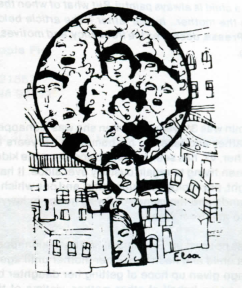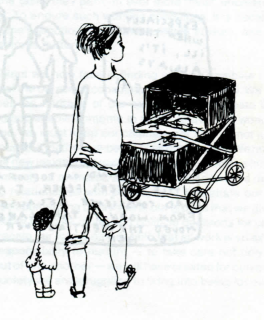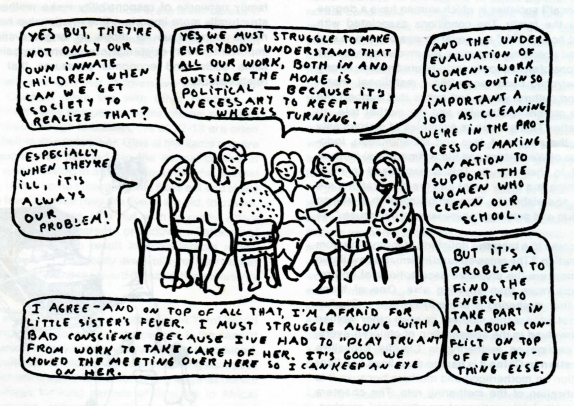The article below, writier) by Patty Walton and originally published by Women (USA) is a cross cultural look at motherhood. The author suggests that the rich diversity of women's experiences underscores an inherent flexibility which lends itself to, and is necessary for, instituting change.
Across Cultures
By examining the rich diversity of ways women experience motherhood we can see more clearly both its connections with the social and physical environment and its flexibility to go beyond present adaptations in response to new conditions. We can also use this information to assure that what we see all around us is not mistaken for "normal" or at least not the only manifestation of normal. This error is racist, ethnocentric and ahistorical, because it makes non-white, non-western, and noncapitalist
practices "abnormal". We are all familiar with the findings of psychologists who pre-suppose the existence of the most oppressive qualities of the nuclear family and the mothering behaviour that accompanies it. It is important to counter this with information revealing that mothering everywhere does not isolate women or make them dependent on men. In hunting and gathering and horticultural societies women are often found working together, and theirchildren follow or are taken care of in other ways convenient to their society. Through this work women sometimes collect or grow the major amount of protein and /or calories they and their children need.
It is not everywhere arranged that children live with their biological parents. Children often live with other relatives, in special houses, or with only one parent. In matrilineal societies (descent is reckoned through females) boys of 12-13 are often sent to live with their mother's brother. Girls of the same age are married or are soon to be married. "In the normal course of events, children visit kin living in other communities for several months at a time. Under some arrangements boys eat and sleep in a men's house from the time they are five years old. In others, once weaned no child sleeps In a hut with sexually active parents — but goes to grandparents or widows... Patterns of
adoption and foster care also result in considerable movement of young children." 1 The ready availability of many other adults to the children contributes toward diffusing the exclusivity of the mother/child focus.
Imperialism has affected patterns of mothering in Third World countries by changing the economy of the people. I n the case of agricultural labourers, money economies have been introduced, separating horticulturalists into peasants with varying access to capital. Where men are drawn into plantations as wage labourers outside of the village for long periods of time (as in Africa) women have become subsistence farmers and assumed responsibility for feeding their children at home alone. Women
on these farms normally extend bonds of cooperation and support to each other.
A culture's characteristic pattern of mothering is an adjustmen to the work that women do and not vice versa. We are not everywhere allotted safe, monotonous, homebased work conceived as a perfect accommodation to our mothering role. Rather, our childcare practices evolve in ways that allow us to carry on the
work that needs to be done given the current economic and social realities of the society in which we live. On examining actual conditions among real people, we find that when women's work takes us regularly away from the home area, children follow or are cared for by only slightly older children or older people. 2 "... Women's work as traders in Africa, or as horticulturalists in many parts of the world, is not made possible by the compatibility of such tasks with childrearing; it is rather that cultural norms with respect to family size and systems of childcare are arranged to conform with women's customary work requirements... the collection of non-cultivated food by
women among some gatherers is not suit to childrearing, and seems to coincide with small family size. Fertility rates also tend to be low in societies where women do very heavy and prolonged horticultural labour, as in parts of New Guinea." 3 To accommodate women's work in societies where it takes them away from children, mothering is not the exclusive domain of mature women but can be shared "with slightly older children, sometimes with small boys as well as with small girls, with other women who are relatives or neighbours, and also with old women, old men, and often for extended periods of a day with men of mature age." 4 Mothers nurse their babies before and
after work if they have to go to distant fields or trading centres every day, and solids are introduced early. Among the Javanese, babies are brought to their mothers at the market to be nursed. 5 And among some people a woman's mother and sisters sometimes share in breastfeeding.
Among Black American women, motherhood, "although an important and expected role — is not mutually exclusive to working outside the home." 6 Black mothers often support their daughter's mothering materially by providing childcare or housing.
The needs of developing socialist countries usually require women's labour outside of the home. In China, for example, women take two half hour breaks to nurse children. 7 Creches are also located next to women's work areas (usually light industry). 8 This encourages collective responsibility toward children. People who wouldn't normally encounter children do; they see their needs as well and are encouraged to take part in their care. Similarly, when children are kept "in view" in hunting and gathering societies, they are not the exclusive moral responsibility of the mother. Integrating mothering into society means integrating children into society. Mothering becomes a public and socialized responsibility.
How then did giving birth and physical motherhood come to be synonimous with the individual mother/nurturer? How is women's exclusive ability to bear children related to the development of sex roles? What will mothering mean without sex roles? Biological-determinant-oriented anthropologists contend that it is physical motherhood that accounts for our mothering role in society. Similarly, Nancy Chodorow states that "women's motherhood and mothering role seem to be the most important features in accounting for the universal secondary status of women." 9 But the body of her paper includes only Western, industrialized, capitalist countries to substantiate this
"universal". She overlooks the fact that "features" may not be causes and may not account for anything. They can appear together and yet be aspects of a common cause or causal interaction. Our mothering role and our oppression can both be connected to the economic and technological resources available for our society's use in exploiting the environment. Chodorow sees the mother's primary responsibility for childcare continued after childbirth because of convenience in facilitating nursing. But we have seen that this has not meant that women take exclusive care of all children.
While it is generally agreed among anthropologists that a matriarchal period does not seem to have existed in human cultural evolution, there are, nevertheless, certain mothercentred ("matrifocal") societies in which women have a degree of power within the family. The conditions associated with "mother-centred households" are equal access of women and men to social and economic resources; the involvement of the mother in decisions of an economic or kin-related nature; strong structural mother/child bonds and often a matrilineal, matrilocal pattern; and cultural values and myths that support the centrality of the mother relationship and the mother role. 10
In the four societies Tanner uses as examples of matrifocality (the Atjehnese, the people of Java and Minangkabau, Indonesians, the Igbo of West Africa and Black Americans) motherhood is central to their culture. This is expressed in ritual priorities — birthing is a major event and the celebrations are woman-centred and elaborate. Through giving birth a woman "becomes an adult and gets legal possession of her house." 11
Is it possible to come to a tentative definition of mothering from the above information ? The cross-cultural information available on mothering uncovers the projected assumptions of anthropologists perhaps more than anything else. One of these assumptions is that mothering is primarily childcare. Studies show that it is not necessarily mothers or even other women who are singly involved in the socialization of children everywhere. In the section on mothering in Claudie Broyelle's Women's Liberation in China it is hard to draw lines and filter out the information on motherhood and mothers because it is about the socialization of the mothering role. The chapters
follow children and their interactions at grandparents', creches, schools and work (and the integration of these institutions) while the mothers are working — in production during the day and politically at night. Mothering is being made a shared social function.
For people in various cultures having children is often seen as a critical juncture in a woman's life, a moment which is incorporated into a culture's institutions and ideologies. Childbirth is often marked by rituals centred around either the child or the mother or both. There also seems to be many social rewards for having children. A woman may be accorded full adult status. Motherhood often gives us our only access to power, self-worth, control and prestige in society, part of which derives from our children's behaviour. Raising children "correctly" is often our only insurance for security in old age. Children are often the only thing we have that contributes directly to our social standing which is not a vicarious expression of a husband's achievement. Even so, children are not everywhere seen as women's inalienable right or property. In some patrilineal societies where property inheritance is stressed the children belong to their father's relatives and are thereby alienated from their mothers. The mother would not be permitted to take them with her if she left her husband.
We have seen, then, that mothering is viewed differently by people is varying circumstances. It is viewed as anything from a means of perpetuating lineality toasource of costly worries to a means of economic survival, to all of these things.
Mothering can also be defined as a structural relationship between a mother and her children. Motherhood in preindustrial societies is not an individual choice because it
involves entire kin groups and their expectations and fulfillment of important social obligations, often involving material exchange or transfers of property at children's life cycle rituals. (Childlessness is a major cause of divorce in situations where these exchanges are stressed.) Like marriage, motherhood solidifies an alliance between two whole sets of relatives as well as (sometimes almost incidental to) a relationship between two individuals. Having children creates new reciprocal obligations between these families. But in post-industrial societies privatization of relations between people and the breakdown of family networks of responsibility make motherhood at once
structurally more important (the relationship has to fulfil more needs to make up for those no longer available) and less important (its very existence is threatened by being bound to the same social and economic pressures that destroy other relationships).
As women we are commonly seen as "natural" In connection with our body's mothering functions. When nature is opposed to culture we are devalued through this association. But motherhood, like all other areas of our lives, does not occur naturally. It is first of all a cultural process, a set of learned behaviours and values. The biological is complicated by being carried out within a social, economic and political mileau that provides acceptable conditions under which pregnancy occurs, childbirth is experienced, and the "good mother" is defined. Cultural practices and expectations surrounding motherhood are finely tuned to coordinate with the general needs of society. In meeting these needs, however, the cultural provisions partially take on a life of their own, and their elaborate nature often makes it difficult to determine which has dominance at any one time.
New conditions often spur new ideas about all areas of life — including mothering. The expression of these new ideas can then change or accelerate changes in the rest of society. The new condition facing American women today is that women with children have been drawn to a greater participation of life outside of the home. This enlarges and intensifies our contact with each other. But we are still largely and singly responsible for mothering and work in the home. This double responsibility is anachronistic, a social arrangement that fit a time when our role in the nuclear family was a way of providing a launderer, food preparer, purchaser, and emotional buttress for male workers
and a caretaker for future workers. Now women work and need others to do these same chores for txjth themselves and their families. When this contradiction is resolved, our mothering will be very different from what we know today. Perhaps then we will be free to mother each other, our children, and ourselves without the limitations and fears of conforming to the role model of another era.
NOTES
1. Ernestine Friedl, Women and Men, An Anthropologist's View (New York: Holt, Rinehart and Winston, 1975), p. 96.
2. Friedl, p. 8.
3. Friedl, p. 60-61.
4. Friedl, p. 60
5. Nancy Tanner, "Matrifocality in Indonesia and Africa and Among Black Americans," In Women, Culture and Society, ed. Michelle ZImbaiist Rosaldo and Louise Lamphere (California : Standford University Press, 1974), p. 136.
6. Tanner, p. 154.
7. Claudle Broyelle, Women's Liberation in China (Atlantic Hlghj lands, New Jersey: Humanities Press, 1977), p. 102.
8. Kattileen Gougti, Ten Times More Beautiful — The Rebuilding of Vietnam (New York: (Monthly Review, 1972), p. 72.
9. Nancy Chodorow, "Family Structure and Feminine Personality," in Women, Culture and Society, ed. Michelle Zimbalist Rosaldo and Louise Lamphere (California: Standford University Press, 1974), p. 45.
10. Tanner, p. 13
11. Tanner, p. 131-137


